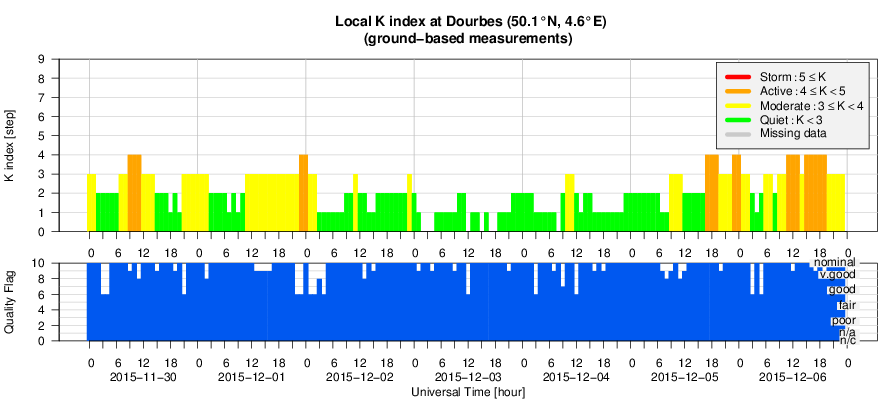- Table of Content
- 1.SWSC: New Topi...
- 2.Happy Birthday...
- 3.ESWW12 - Spot ...
- 4.PROBA2 Observa...
- 5.Review of sola...
- 6.The Internatio...
- 7.Review of geom...
- 8.Geomagnetic Ob...
- 9.Review of iono...
- 10.Future Events
2. Happy Birthday SOHO
3. ESWW12 - Spot yourself
4. PROBA2 Observations (30 Nov 2015 - 6 Dec 2015)
5. Review of solar activity
6. The International Sunspot Number
7. Review of geomagnetic activity
8. Geomagnetic Observations at Dourbes (30 Nov 2015 - 6 Dec 2015)
9. Review of ionospheric activity (30 Nov 2015 - 6 Dec 2015)
10. Future Events
SWSC: New Topical Issue
The Journal of Space Weather and Space Climate (SWSC - http://www.swsc-journal.org/ ) plans a topical issue on "Brightness Variations of the Sun and Sun-like Stars and Resulting Influences on their Environments", to appear in 2016. This interdisciplinary issue will include contributions to the 2015 Sun-Climate Symposium (http://lasp.colorado.edu/home/sorce/news-events/meetings/2015-sun-climate-symposium/ ) and to the IAU General Assembly's Focus Meeting 13 "Brightness Variations of the Sun and Sun-like Stars" (http://www.iau.org/science/events/1140/ ). We welcome contributions that cover various aspects of solar and stellar magnetically driven variability, including among others:
- Observations of solar and stellar brightness variability
- Physical mechanisms and models of solar and stellar variability
- The solar-stellar connection. Is the Sun a solar-type variable?
- The impact of solar and stellar variability on their environment
- Sun-Climate Connection: mechanisms, climate change
- Future observing programmes and missions
Manuscripts must be submitted via the SWSC online submission tool (https://articlestatus.edpsciences.org/is/swsc/ ).
Note that the publication fees, presently 500€+tax, will increase to 700€+tax for manuscripts submitted after 31st December 2015.
All manuscripts will be peer reviewed according to the quality standards of international scientific journals. The type of contributions must fit the style of SWSC. All manuscripts should contain enough new insight, present the results against a properly referenced background of existing work, and present adequate evidence that supports the conclusions. Accepted papers are published in electronic format only, and are freely available to everyone via the SWSC web site. SWSC offers the possibility to include electronic material, such as animations, movies, codes and data.
The guest editors for this Topical Issue are:
- Greg Kopp
- Natalie Krivova
- Alexander Shapiro
- Yvonne Unruh
For questions regarding this topical issue, please contact any of the guest editors. For questions concerning the submission process, the Editorial Office (swsc(at)edpsciences(dot)org) should be contacted.
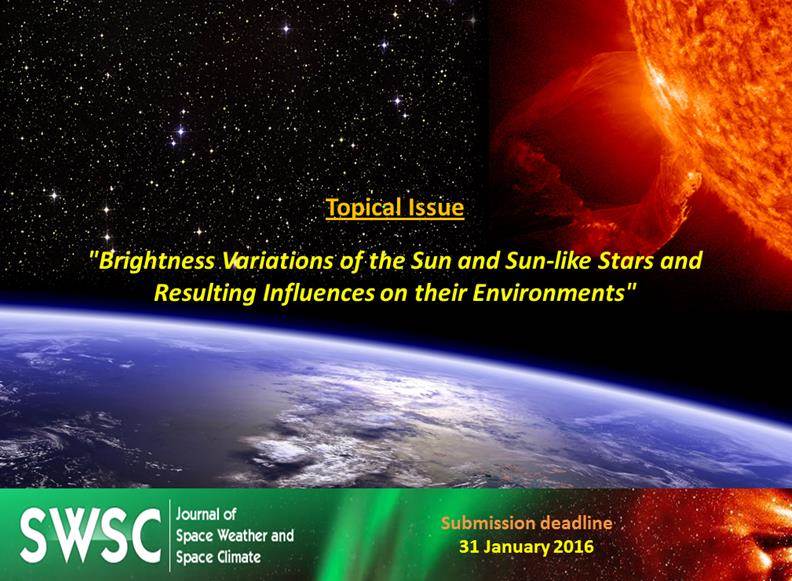
Happy Birthday SOHO
On 02 December 2015, the Solar and Heliospheric Observatory (SOHO, http://sohowww.nascom.nasa.gov ) will celebrate its 20th birthday. Since its launch in 1995, this versatile spacecraft has become an icon in solar and heliospheric research, and has provided space weather forecasters a solid base to build on.
SOHO, a combined ESA/NASA project, revolutionized space weather monitoring by providing imagery of the Sun in white light, 4 wavelengths in extreme ultraviolet, and magnetograms at a cadence of several images per hour. Its coronagraphs provided a view of the immediate surroundings of the Sun, allowing a good view on the dreaded coronal mass ejections. More importantly, these images were available in near real-time, something unseen up to that time.
SOHO instruments have contributed to several other research domains, such as the solar wind (parameters, origin) or the solar interior (oscillations). The spacecraft is also the best comet chaser in history, having made its 3000th (three thousand!) comet discovery just a few months ago (13 September 2015).
SOHO had a near-death experience in 1998 after a loss of control on 24 June. Fortunately, ground controllers heroically regained contact with and control of the spacecraft over the next few months. It's the single period in SOHO's operational life without imagery, and it became known as 'SOHO's holiday'. Eventually, this workhorse of the solar scientists and space weather specialists would become superseded by the Solar Dynamics Observatory in 2010, which had a much higher resolution and image cadence. However, the telemetry gained by stopping SOHO's solar disk imagery was used to boost the cadence of the coronagraphic images to one image every 12 minutes, for both coronagraphs. That is why, up to this day, SOHO remains the main spacecraft delivering the so critical coronagraphic imagery.
The movie accessible through http://www.stce.be/news/328/welcome.html is a small selection of the most spectacular events observed by SOHO. More information, imagery, contests, etc. can be found on the SOHO website.
Many congratulations to the SOHO team and all who contributed to this ongoing and incredibly successful solar mission!
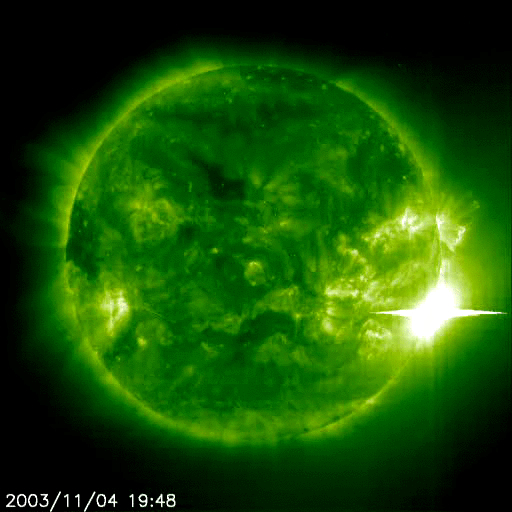
ESWW12 - Spot yourself
If you were at ESWW12, you were probably being captured by our house-photograph.
Check it out - top menu 'PICTURES' : http://www.stce.be/esww12/
Case studies and exploring new environments:

PROBA2 Observations (30 Nov 2015 - 6 Dec 2015)
Solar Activity
Solar flare activity was low this week.
In order to view the activity of this week in more detail, we suggest to go to the following website from which all the daily (normal and difference) movies can be accessed: http://proba2.oma.be/ssa
This page also lists the recorded flaring events.
A weekly overview movie can be found here: http://proba2.sidc.be/swap/data/mpg/movies/weekly_movies/weekly_movie_2015_11_30.mp4 (SWAP week 297).
The week's activity was dominated by two Active Regions. At the beginning of the week, AR 2458 produced a series of C-class flares until it disappeared behind the West limb. In the second half of the week, AR 2463 was most active, also producing a series C-class flares.
Below we provide SWAP images showing some nice examples of C-class flares from the active regions mentioned above. The annotated snapshots are produced by the Solar Feature Automated Search Tool (SoFAST). This tool detects dynamic solar events in EUV images from SWAP in near real-time. The snapshots illustrate the location of the flare on the solar disk (right) and a zoomed image (left).
The complete SoFAST online event list and additional plots are available onhttp://www.sidc.be/sofast.
2015-Nov-30, AR 2458:
C1.0 peaking around 17:06 UT
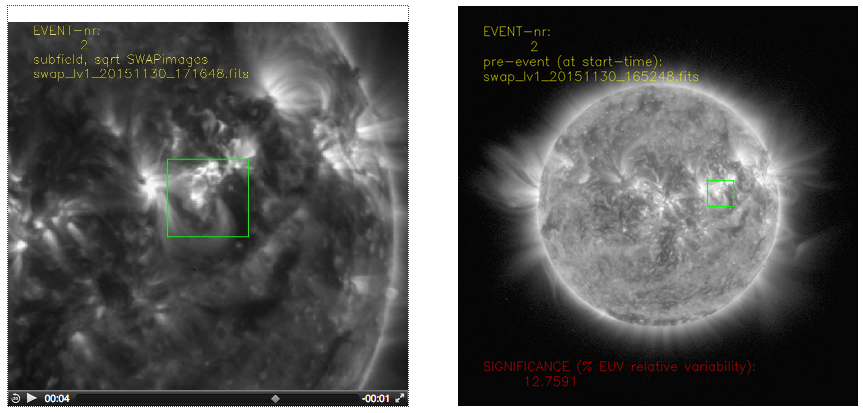
2015-Dec-01, AR 2458:
C3.6 peaking around 08:10 UT
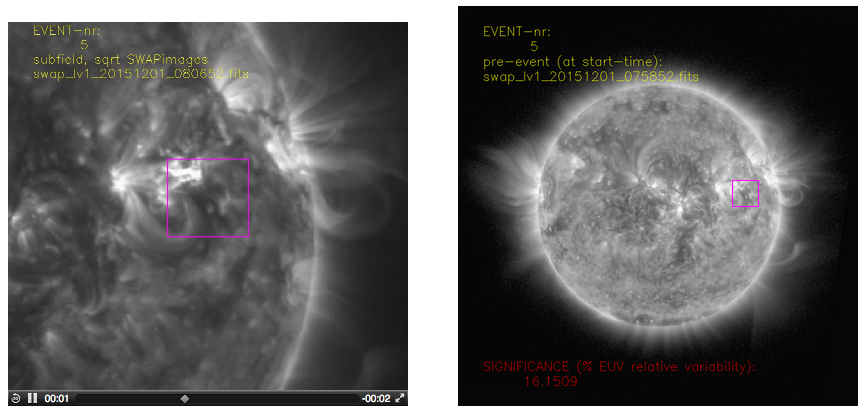
2015-Dec-04, AR 2463:
C4.0 peaking around 17:10 UT
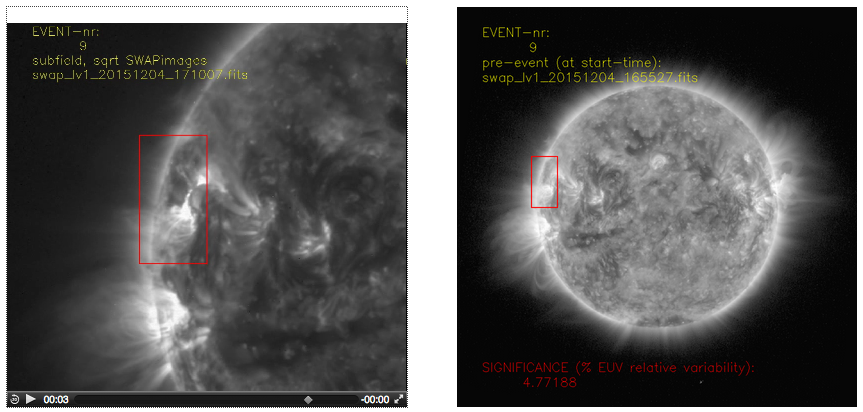
Review of solar activity
Flares
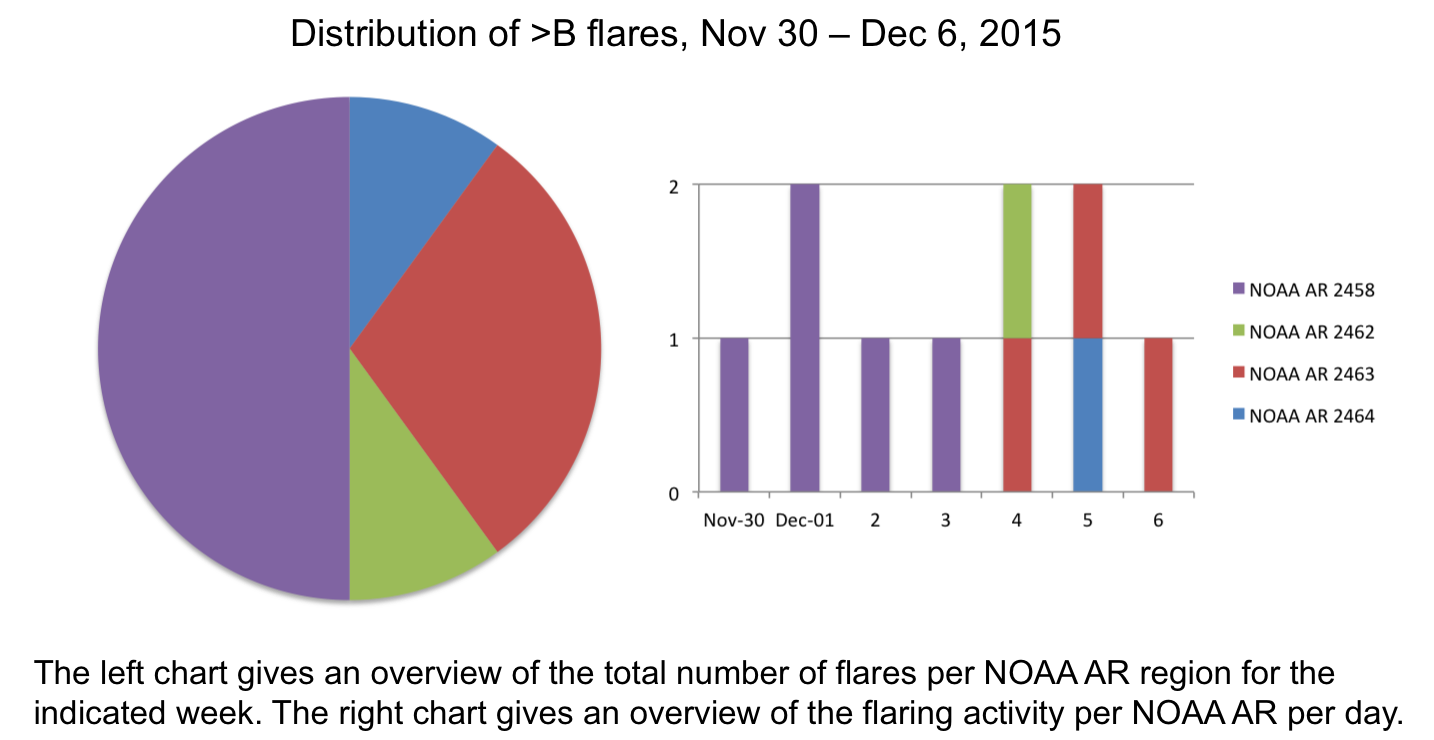
At the beginning of the week Active Regions (AR) 2458 and 2459 were the most active, showing continual flux emergence and producing a series of C-class flares. On Thursday 2015-Dec-03 they rotated onto the West limb and appeared less active. Over 2015-Dec-04 / 05 ARs 2462 and 2463 rotated into view over the Eastern limb. These regions also produced a series of C-class flares. AR 2462 produced the biggest flare, an estimated C4.5 flare peaking at 17:10 UT on Saturday 2015-Dec-05.
Coronal Mass Ejections and protons
There were no significant Earth directed CMEs observed throughout the week. A couple of larger back-sided/limb events were observed throughout the week. However, there was evidence of an Earth directed CME in EUV observations on Tuesday 2015-Dec-01 but a lack of Coronagraph observations prevented an accurate arrival forecast. However, the magnitude of the flare, associated wave, and dimming indicated the CME was weak.
Solar Proton levels remained at background levels throughout the week.
Coronal Holes
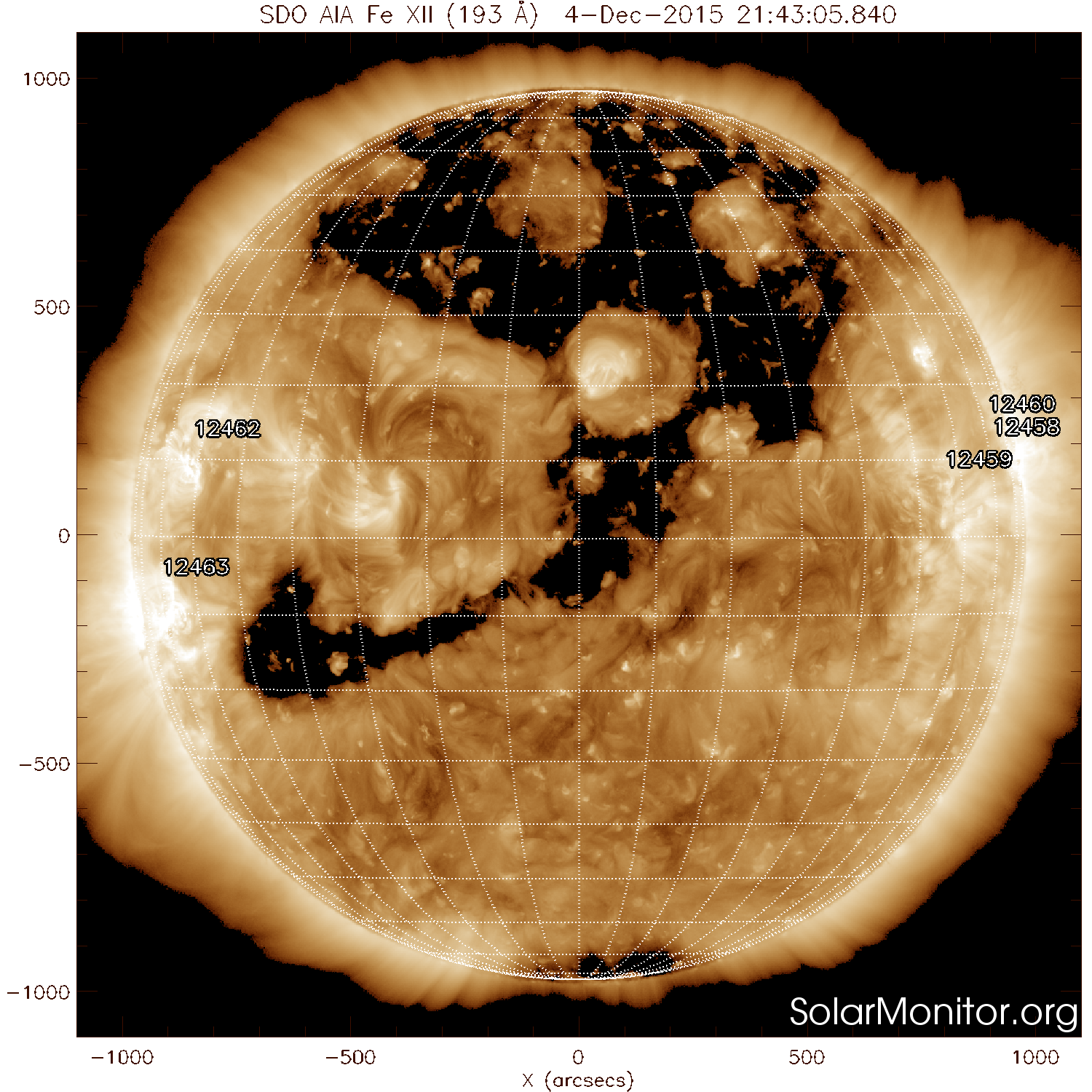
At the beginning of the week a small coronal hole (CH) was magnetically connected to the Earth. From Saturday 2015-Dec-05 onwards, the solar wind emanating from a large positive polar coronal hole, with a section extending to low latitudes, enhanced solar wind conditions near Earth over the weekend.
The International Sunspot Number
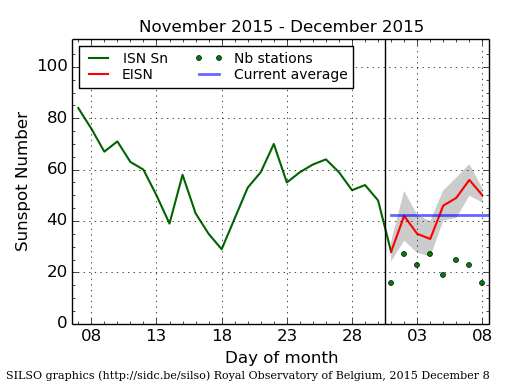
The daily Estimated International Sunspot Number (EISN, red curve with shaded error) derived by a simplified method from real-time data from the worldwide SILSO network. It extends the official Sunspot Number from the full processing of the preceding month (green line). The plot shows the last 30 days (~ one solar rotation). The horizontal blue line shows the current monthly average, while the green dots give the number of stations included in the calculation of the EISN for each day.
Review of geomagnetic activity
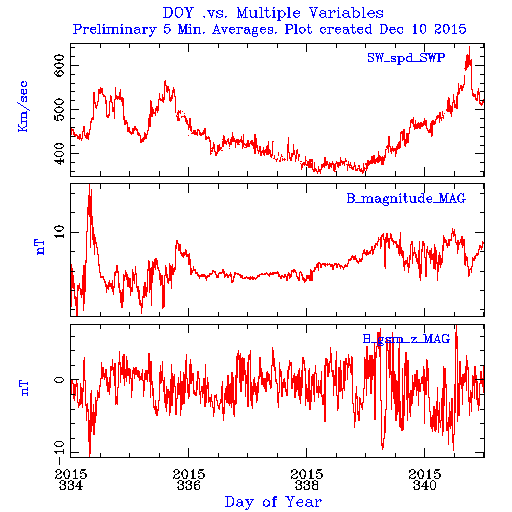
ACE data from Nov 30 (DOY 334) until Dec 6 (DOY 340)
The solar wind speed (top panel) was low most of the week, around 400-450 km/s, with a small enhancement early in the week due to a small CH, and again later in the week, from Saturday 2015-Dec-05, when it reached speeds around 600 km/s due to a large positive polar CH, with a section extending to low latitudes, and enhanced solar wind conditions over the weekend.
Similarly, the total magnetic field strength (middle panel) has been mainly around 7 nT throughout the week, with small enhancements due to the two above mentioned coronal holes. The Bz component (lower panel) has oscillated between positive and negative all week, spending most of that period varying between +7 nT and -7 nT.
Geomagnetic conditions ranged between quiet and active (NOAA Kp 0-4, local K Dourbes 1-4). A small Earth directed CME detected in EUV observations on Tuesday 2015-Dec-01 did not appear to effect geomagnetic conditions at the Earth, but accurate travel times could not be made due to a lack of coronagraph observations.
Review of ionospheric activity (30 Nov 2015 - 6 Dec 2015)
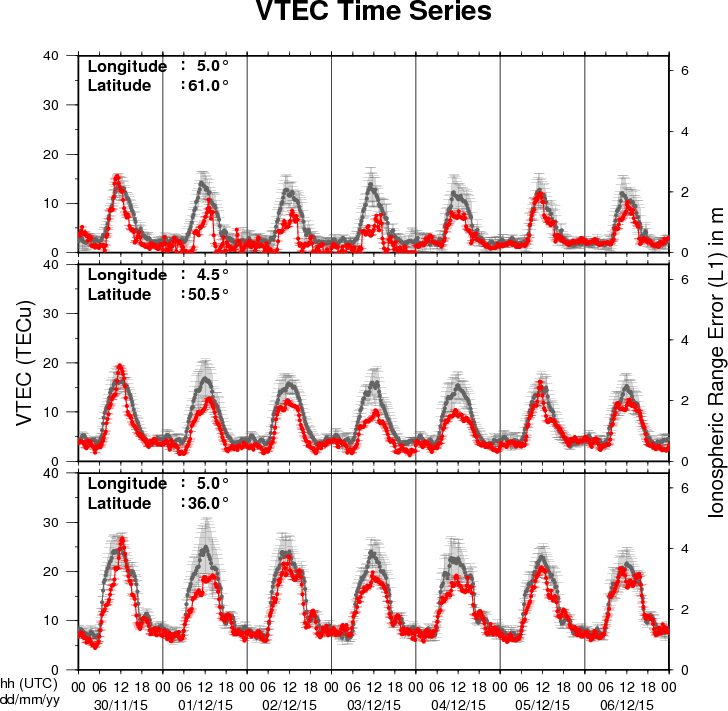
The figure shows the time evolution of the Vertical Total Electron Content (VTEC) (in red) during the last week at three locations:
a) in the northern part of Europe(N61°, 5°E)
b) above Brussels(N50.5°, 4.5°E)
c) in the southern part of Europe(N36°, 5°E)
This figure also shows (in grey) the normal ionospheric behaviour expected based on the median VTEC from the 15 previous days.
The VTEC is expressed in TECu (with TECu=10^16 electrons per square meter) and is directly related to the signal propagation delay due to the ionosphere (in figure: delay on GPS L1 frequency).
The Sun's radiation ionizes the Earth's upper atmosphere, the ionosphere, located from about 60km to 1000km above the Earth's surface.The ionization process in the ionosphere produces ions and free electrons. These electrons perturb the propagation of the GNSS (Global Navigation Satellite System) signals by inducing a so-called ionospheric delay.
See http://stce.be/newsletter/GNSS_final.pdf for some more explanations ; for detailed information, see http://gnss.be/ionosphere_tutorial.php
Future Events
For more details, see http://www.spaceweather.eu/en/event/future
COSPAR/ILWS workshop: science for space weather in Goa, India
Start : 2016-01-24 - End : 2016-01-29
Understanding and being able to forecast space weather is an
increasingly important aspect of our modern technology-reliant
society. This workshop will treat all aspects of space weather,
ranging from solar origins of transient events (CMEs, Flares, CIRs)
to their propagation through the heliosphere and effects on Earth
and planetary bodies, from particle energization to forecasting
particle environment and its effects on technological and
biological systems, as well as solar-cycle effects and coupling of
space weather to atmospheric response. Metrics to assess
predictions will also be discussed. The workshop is structured
along the lines of the COSPAR space weather pathways and will
include invited, contributed talks and posters, as well as panel
discussions and tutorials.
Website:
http://www.cessi.in/ssw/program.html
The Scientific Foundation of Space Weather
Start : 2016-06-27 - End : 2016-07-01
Website:
http://www.issibern.ch/program/workshops.html
